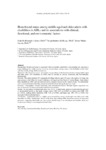Homebound status among middle-aged and older adults with disabilities in ADLs and its associations with clinical, functional, and environmental factors

Ver/
Use este enlace para citar
http://hdl.handle.net/2183/20007
A non ser que se indique outra cousa, a licenza do ítem descríbese como Creative Commons Attribution-NonCommercial-NoDerivatives 4.0 International License (CC-BY-NC-ND 4.0)
Coleccións
- Investigación (FEP) [507]
Metadatos
Mostrar o rexistro completo do ítemTítulo
Homebound status among middle-aged and older adults with disabilities in ADLs and its associations with clinical, functional, and environmental factorsData
2016-06-29Cita bibliográfica
De-Rosende Celeiro I, Santos-del-Riego S, Muñiz García J. Homebound status among middle-aged and older adults with disabilities in ADLs and its associations with clinical, functional, and environmental factors. Disabil Health J. 2017;10(1):145-151
Resumo
[Abstract] Background. Homebound status is associated with poor health, comorbidity, and mortality and represents a major challenge for health systems. However, its prevalence among people with disabilities in the basic activities of daily living (ADLs) is unknown.
Objectives. The objectives were to: (1) examine the prevalence of the homebound status among middle-aged and older adults with disabilities in ADLs, and (2) identify its clinical, functional, and environmental determinants.
Methods. This study included 221 community-dwelling subjects, aged ≥50 years, who applied for long-term care services at the Office for Legal Certification of Long-term Care Need of Coruña (Spain). Each subject had a disability in ADLs and was interviewed by a trained examiner in the subject's home. The participants were considered homebound if they remained inside their home during the previous week.
Measures. Demographic, clinical, functional, and environmental factors. Multiple logistic regression was used to determine the factors associated with homebound status.
Results. The prevalence of homebound status was 39.8%. A multivariate analysis revealed that the presence of architectural barriers at the home entrance (stairs [OR: 6.67, p < 0.001] or a heavy door [OR: 2.83, p = 0.023]), walking ability limitations (OR: 3.26, p = 0.006), and higher age (OR: 1.05, p = 0.04) were associated with homebound status.
Conclusions. Homebound status is a highly prevalent problem among middle-aged and older adults with disabilities in ADLs. Architectural factors in the home and walking ability limitations seem to be important predictors, suggesting that health care interventions should target home adaptations and mobility skills as a means to preventing or decreasing homebound status.
Palabras chave
Accesibility
Functional disability
Homebound status
Mobility
Prevalence
Functional disability
Homebound status
Mobility
Prevalence
Descrición
Brief Report
Versión do editor
Dereitos
Creative Commons Attribution-NonCommercial-NoDerivatives 4.0 International License (CC-BY-NC-ND 4.0)
ISSN
1936-6574
1876-7583
1876-7583






